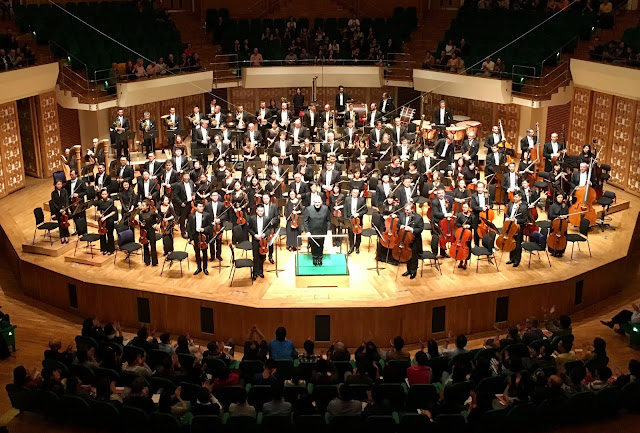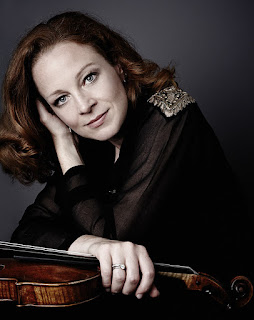Hong Kong Cultural Centre Concert Hall, 27 April 2019
Symphony no. 9 (Mahler)
Hong Kong Cultural Centre Concert Hall, 4 May 2019
Piano Concerto no. 20 (Mozart)
Symphony no. 7 (Bruckner)
Khatia Buniatishvili (piano)
Hong Kong Cultural Centre Concert Hall, 18 May 2019
Christus factus est (Bruckner)
Ave Maria (Bruckner)
Symphony no. 2 (Mahler)
Ying Fang (soprano)
Karen Cargill (mezzo-soprano)
Netherlands Radio Choir
Hong Kong Philharmonic Chorus
Hong Kong Philharmonic Orchestra
Jaap van Zweden (conductor)
These three performances made an ambitious showcase of the late romantic symphonies during Jaap's spring residence with the philharmonic. The augmented orchestra with extras in brass, wind and percussion reminded us the large orchestration deployed in the Wagner ring project before. It was a demonstration how the orchestra has progressed technically and musically under the baton of Jaap. The produced tone was often meaty and confident. Though sometimes it has its temperament of inconsistency at the recent indifferent rendition of Nutcracker for the Hamburg Ballet. When it is on top form and knowing the direction, it was left to a matter of interpretation and execution.
Among the three symphonies, Mahler's ninth symphony was the most progressive and sophisticated of all. The composer probably found the ultimate resolution to his long obsession of repeated emotional struggle between love and traumatic abyss since symphonies at the Wunderhorn period. Bernstein suggested the last movement a gesture of farewell to the world, yet I thought it was Mahler finally parting away from the emotional negotiations he had been seeking so long.
Jaap emphasised the emotional contrast by adding a sheer sense of dramatic intensity, but sometimes overdoing it that felt too deliberate for a theatrical drama. A sticky start to the moody opening of first movement that led to the rocking lyric theme being playing passionately. The first climax was a crushing devastation, and the following ebb and flow remained vigorously expressive. Effective dynamic and emotional contrast that differentiated the mysterious tiptoed like transition passage and the third reappearance of the rocking theme.
The next climatic point was explosive with a rich and bold sound body, which was different from the mysterious bare sound landscape that followed. It felt more wholeheartedly triumphant as the orchestra developed another exuberant climax, but quickly vanished by a crushing blow from the brass that hinting a sense of last judgement. The main theme turned melancholy and became a march. A rhythmically tricky duet for the horn and flute and concluded with a flute solo that depicted darkness loomed in the atmosphere.
The second movement switched the emotional focus to the bold and coarse Landler dance. Jaap's interpretation was bombastic, hurried and flamboyant. It felt sticky at first and gradually gained more momentum. The gallop carried the sheer energy and swinging wildly. An audible slip from the clarinets though. The wildness grew to fullness in the grotesque third movement. The wind playing gave a mad impression of chaos throughout the complex fugal passage. The tender entry of the solo trumpet changed the atmosphere to another bold and exciting climax midway before the final recapitulation of madness.
The tutti strings began the last movement with an outpour of emotions. The warm tone made a rather positive impression before reaching the reflective mid section. The texture became leaner that carried a sorrow sense, and further reinforced by the horns on sustaining the emotional ebb and flow. A calm transition was played by the wind quartet before pushing towards a climatic point. The brass fanfare reinforced the strings to announce the radiance of love without any further reservation of irony. Jaap seems interpreted with more hope than bleakness. Towards the spellbinding end, it was felt alike the composer had found a resolve to his long search of question between hope, love, loss and death.

Despite the tender touch Khatia demonstrated in Mozart's twentieth piano concerto was elegant and seamless, her adopted tempo felt too slow at times. The orchestra and Jaap instead wanted to get it going than indulging too much. Khatia's playing carried a dense tragic colour in the first movement. Her weight on the keyboard not aggressive and carried the weight of colours. The cadenza was dramatic in contrast from the subtle impression before.
She redeployed the soft touch in the tender introduction of second movement. Though the same dynamic for the tempestuous mid section undermined the growing sentiments. The recapitulation even felt like a lullaby. It was increasingly frustrating to hear her holding the excitement further for a mysterious impression in the last movement. The cadenza filled with sentiments that felt odd to rush the coda at break neck tempo.
Compare to previous two encounters of Jaap conducting Bruckner's 4th and 8th symphony, the 7th emphasised on blazing sound but not so much a musical narration. The strings made a majestic introduction yet the upper strings were not quite together with the winds. Beautiful flute playing in the wind trio followed by a tragic passage in the lower strings. A complex sentimental negotiation of a vast sound world between heaven and earth went on. The brass ended it on a confident fanfare to create a long chord of a full blown pipe organ.
A huge sound of the majestic theme began the second movement emotionally forward. A lyrical part for the strings to play in unison with richness. The crescendo led to a climatic peak accompanied by another glorious brass fanfare before resetting to a bare landscape. It ended on a solemn announcement by the horns with a flute solo leading to a delicate pause.
A wild but bold gallop started the third movement which culminated the intensity for an explosive climax. The ebb and flow of emotion was followed by a pastoral mid section which the main theme was more romantic driven. The recapitulation was unhurried and grand. The introduction of the last movement became more witty and optimistic at first. The brass fanfare put the melancholy dialogue between the woodwind and strings aside. There was even a hint of recalling Wagner's music painting of the Rhine river yet the under grow development felt random. In contrast, the thundering brass theme added more confidence and certainty to the triumphant conclusion.

In the next programme, two familiar motets by Bruckner were sung by the Netherlands Radio Choir prior to Mahler's 'Resurrection' Symphony. Though I was puzzled why the Philharmonic Chorus was not performing the motets together with the Dutch choir. Klaas Stok, the choirmaster of the Radio Choir, took a rather vertical approach to 'christus factus est' with a dragging tempo. The dynamic contrast was effective from the choir yet not a dramatic execution of the music. Klaas's conducting also did not help to get the parts together and there were some untidy corners. 'Sancta Maria' was emphasised particularly through the diction in the 'Ave Maria'.
The orchestra felt far more confident in the second symphony than the ninth symphony before. The lower strings began the first movement in rage. It made a contrasting picture of hell and heaven when the upper strings played the heavenward theme with warmth. The wild tutti gallop which followed shattered the sweet pastoral picture before. Gradually it developed to a triumphant climax until the violent passage returned once again in sheer intensity. The brass played the theme bold and full in contrast to the calm and tender closing.
The dance in second movement was gentle and gracefully played in a warm tone. Jaap took the tempo on the fast side to keep the waltz elaborate and optimistic. Nervousness returned in the third movement and, despite carrying the forwardness in momentum, the upper strings were not tidy in the note heavy passage. The melancholy gallop culminated to a wild and explosive climax, which the percussions effectively built up the theatrical intensity. Karen Cargill phrased the fourth movement poetically yet the orchestra was not that responsive to her deployed rubato. Her diction was sometimes cloudy and a rather bright timbre for the part.
The musical narration of last judgement to resurrection was vividly portrayed in the final movement. After a brief recapitulation of the opening of the first movement, the brass announced the judgement theme steadily. The majestic impression left no room for cliche and a heavenward glimpse was gloriously rendered. In contrast, the tutti devastation that followed was crushingly loud and wild. The brass reinforced the climax continuously with explosive intensity until the chorus hushed entry. The combined choirs were uncertain at first with Zweden's conducting but grew more confident when the orchestra joined. Ying Fang sang with a clarion clear timbre and complimented Karen very well in their duet. The excitement was hold back until the final exultation, which was gloriously rendered for the ultimate salvation.














































